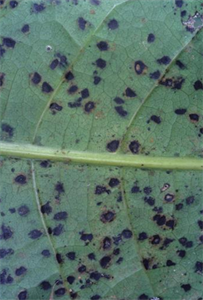Angular leaf spot, mango leaf spot.
Pacific Pests, Pathogens, Weeds & Pesticides - Online edition
Pacific Pests, Pathogens, Weeds & Pesticides
Mango angular leaf spot (325)
Scolecostigmina mangiferae; previously known as Cercospora mangiferae and Stigmina mangiferae. Different from but easily confused with anthracnose, Glomerella cingulata (see Fact Sheet no. 09).
Asia (distribution uncertain), South and Central America, the Caribbean, Oceania. It is recorded from American Samoa, Cook Islands, Federated States of Micronesia, Fiji, French Polynesia, Nauru, New Caledonia, Palau, Samoa, Solomon Islands, Tonga, and Vanuatu.
Mango
The fungus causes leaf spots, circular to angular, up to 6 mm diameter, with small black centres surrounded by wide greenish halos (Photos 1&2). Dark spots on the underside as sporulation occurs (Photo3).
Wind and rain spread the spores that are produced on the underside of the leaves.
The spots on the leaves may merge in wet weather to form large black areas causing leaf fall, but there is little information on the impact of this disease. It often occurs with anthracnose caused by Glomerella cingulata, which results in a more serious disease as it attacks flowers and shoots (see Fact Sheet no. 09). Unlike anthracnose, a post-harvest infection has not been reported.
Look for the small black angular to circular spots, merging in wet weather, surrounded by light-greenish halos.
It is not understood if control measures are required against this disease. Often, it occurs with anthracnose (Glomerella cingulata) making a judgement difficult. If control measures are required, use those recommended for the anthracnose fungus (see Fact Sheet no. 09).
CULTURAL CONTROL
It is important to prune trees to allow air to flow freely through the tree canopy to reduce humidity. Trees should be less than 4 m tall for easy management and harvesting. Diseased twigs should be removed and burnt along with fallen leaves.
CHEMICAL CONTROL
It is unlikely that chemical control is required for the control of angular leaf spot if the disease occurred on its own. It is much more likely that it will be associated with anthracnose. In this case, see Fact Sheet no. 09.
In Australia, several fungicides are registered from the control of anthracnose, including mancozeb, copper (copper hydroxide, copper oxide, copper oxychloride or copper sulphate), prochloraz, or azoxystrobin. See guide to their use: (https://www.dpi.nsw.gov.au/__data/assets/pdf_file/0011/125876/mango-anthracnose-pf19.pdf).
____________________
When using a pesticide, always wear protective clothing and follow the instructions on the product label, such as dosage, timing of application, and pre-harvest interval. Recommendations will vary with the crop and system of cultivation. Expert advice on the most appropriate pesticide to use should always be sought from local agricultural authorities.
AUTHORS Grahame Jackson & Eric McKenzie
Photo 1 Fred Brooks, University of Hawaii at Manoa, Bugwood.org; Photos 1&2 (taken by Eric McKenzie), and used in this fact sheet, appeared previously in McKenzie E (2013) Scolecostigmina mangiferae: PaDIL - (http://www.padil.gov.au).
Produced with support from the Australian Centre for International Agricultural Research under project PC/2010/090: Strengthening integrated crop management research in the Pacific Islands in support of sustainable intensification of high-value crop production, implemented by the University of Queensland and the Secretariat of the Pacific Community.






